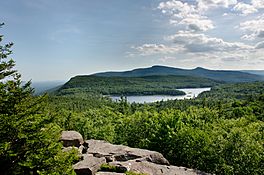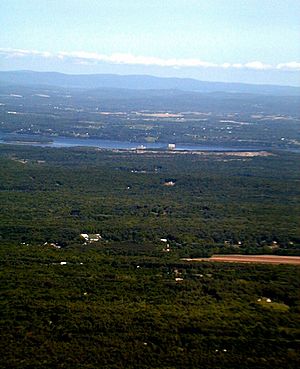North–South Lake facts for kids
Quick facts for kids North-South Lake |
|
|---|---|

View from Sunset Rocks
|
|
| Location | Greene County, New York |
| Coordinates | 42°11′56.87″N 74°2′27.86″W / 42.1991306°N 74.0410722°W |
| Basin countries | United States |
| Surface area | 83 acres (34 ha) |
| Average depth | 5.6 ft (1.7 m) |
North–South Lake is a huge state campground covering about 1,100 acres (4.4 km²) in the beautiful Catskill Forest Preserve. It's located near Palenville, New York, high up on a cliff called an escarpment. From here, you can see amazing views of the Hudson River valley, and on a clear day, you might even spot five different states!
This area has a rich history. It was a favorite spot for famous painters from the Hudson River School, especially Thomas Cole. For a long time, fancy hotels here made the area super popular. Today, North–South Lake is a great place for hiking, swimming, boating (without motors), and fishing.
| Top - 0-9 A B C D E F G H I J K L M N O P Q R S T U V W X Y Z |
Exploring the History of North–South Lake
The North–South Lake area is known as "America's First Wilderness." It played a big part in the history of outdoor fun in the Catskills.
Early Explorers and Nature's Secrets
The story of this area goes back to 1753, even before the American Revolution. A naturalist named John Bartram visited with his son. They came to collect samples of balsam fir trees, which people thought had special healing powers. Even though the trees they took back to Great Britain didn't grow, John Bartram's story about his trip, called "A Journey to Ye Cat Skill Mountains with Billy," became very popular.
Artists Discover the Catskills
In the early 1800s, American artists wanted to find unique subjects for their paintings. They traveled from New York City up the Hudson Valley. They were amazed by the wild beauty of the landscape, especially where the mountains met the river. Further north, they found the Catskill Escarpment, where mountains rise almost 4,000 feet (1219 m) from a flat valley.
Their paintings started a new art movement called the Hudson River School. It was America's first truly American art style. These artists, like Thomas Cole, often painted the two lakes found on the escarpment. Their beautiful artworks helped make the area famous.
Grand Hotels and Mountain Views

In 1823, a group of business people built the Catskill Mountain House. It was located on a famous overlook called "Pine Orchard," which the Bartrams had visited years before. Thomas Cole often stayed there and helped make it even more famous.
In 1839, Charles Beach took over the hotel. He turned it into a top destination for important people, like politicians, business leaders, artists, and writers. It was a place where they could relax, enjoy the views, walk in the forests, and have amazing dinners.
The hotel owners even made up a story about the two lakes. They said an Indian legend claimed the lakes were the eyes of a giant, and the mountain was his body. This story wasn't real, but it added to the mystery of the place.
Other hotels were built nearby, like the Hotel Kaaterskill and the Laurel House Hotel. The Laurel House Hotel was special because it controlled access to one of the area's biggest attractions, Kaaterskill Falls.
To bring guests to these hotels, special narrow-gauge train tracks and an incline railway were built. You can still see where these tracks used to be today, even though the trains are long gone.
A Change in Fame
In the 1880s, the area's reputation changed. A visitor named Arnold Henry Guyot did a survey of the Catskills. He found that the highest mountain wasn't nearby Kaaterskill High Peak, as the hotel owners claimed. Instead, it was Slide Mountain, which was much further away.
The hotel owners tried to argue with Guyot, but by 1886, his findings were proven correct. This meant the North–South Lake area lost some of its special appeal.
In the early 1900s, the hotels started to become less popular. People began to travel to other mountain areas, and automobiles made it easier to take shorter trips. The grand hotels, like the Kaaterskill and Laurel House, were eventually destroyed by fires and were never rebuilt.
Becoming a State Park
In 1929, the state parks department bought some of the land around the lakes. They wanted to protect it and keep it "forever wild" under New York State law. At that time, the two lakes were separated by a dirt dam. The first campground had only 10 sites, but today there are 219! Beaches were added in 1936.
Eventually, the state bought all the land, including the area around the old Mountain House. The Mountain House closed for good in 1940. Even though some people wanted to save the old building for its history, state rules meant most structures on protected land had to be removed. So, the Mountain House was taken down in 1963.
In the 1970s, the dam between North Lake and South Lake was removed. A new dam was built at the end of South Lake, creating one large, beautiful lake.
North–South Lake Today
Today, the campground is very popular. Thousands of people visit every year, either for the day or to camp overnight. It's the most visited state property in the Catskill Park.
Visitors can enjoy many activities, both on the water and on land. The most popular activity is still hiking, just like in the old days of the Mountain House. There are many trails leading to interesting spots like:
- The ruins of the Kaaterskill and Mountain House hotels.
- Kaaterskill Falls.
- Mary's Glen and its small waterfall.
- Many amazing views of the Hudson Valley along the Escarpment Trail. These viewpoints still have their old 19th-century names, like "Artists' Rock." Some even have old carvings from those days!
For those who like a challenge, a hike up North Mountain to North Point offers incredible views.
Closer to the ground, you can find clever balanced-rock displays made by old hotel guests. One famous one is Alligator Rock. It's made of two large rocks that look like an open mouth, and people have added "teeth" over the years to make it look like an alligator.
The Department of Environmental Conservation (DEC) charges a small fee of $10 per car for day visitors between May and October.
North–South Lake was even used in the music video for the song "Alive and Kicking" by the band Simple Minds. That song reached No.3 on the US Billboard charts!





